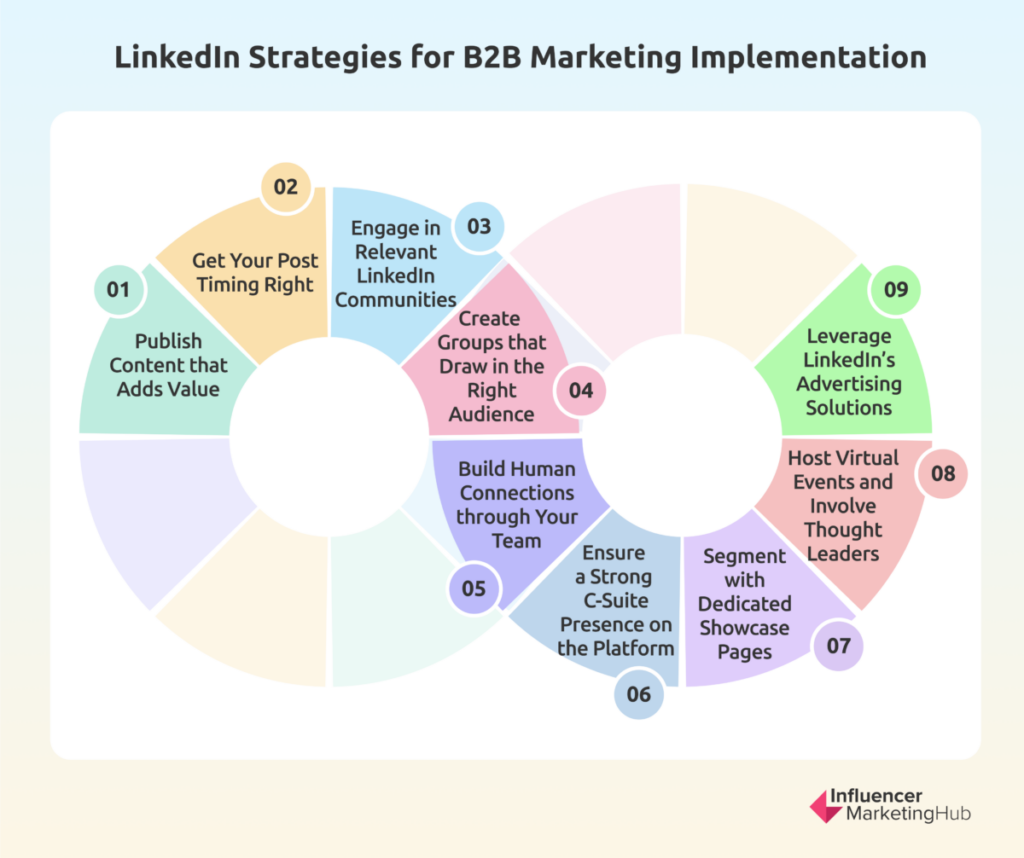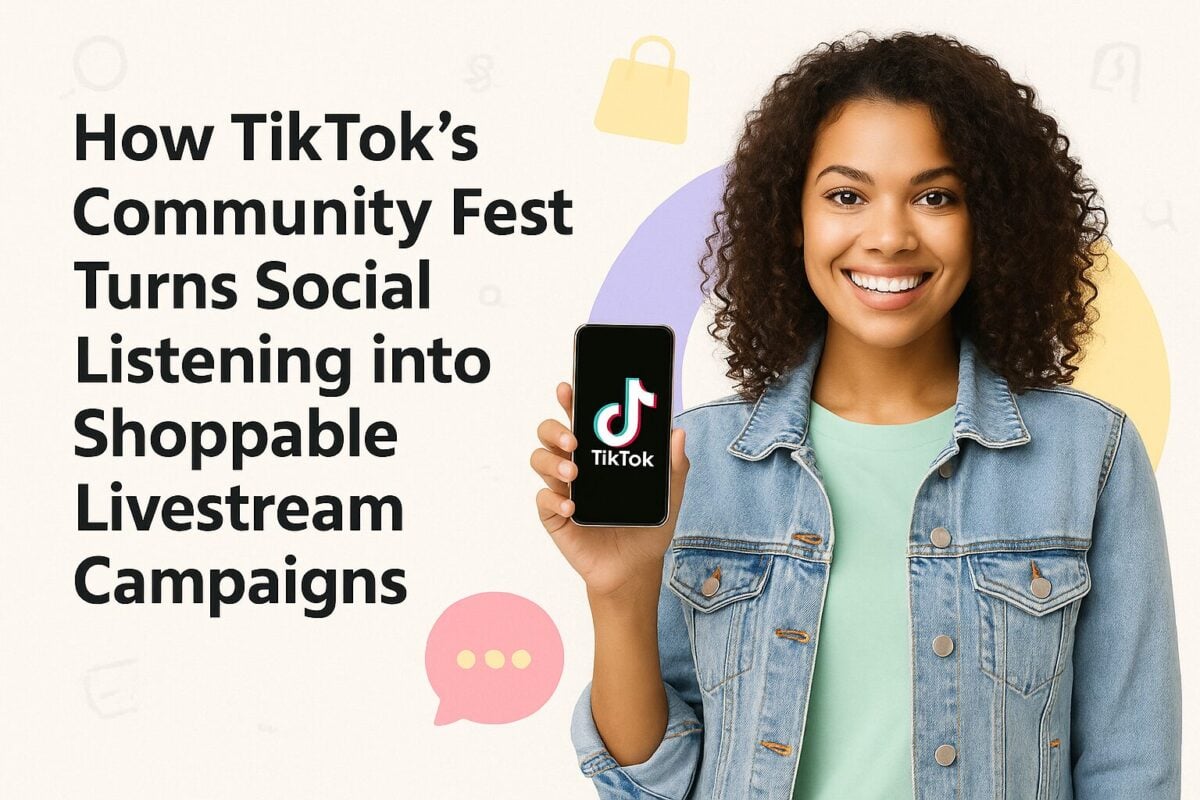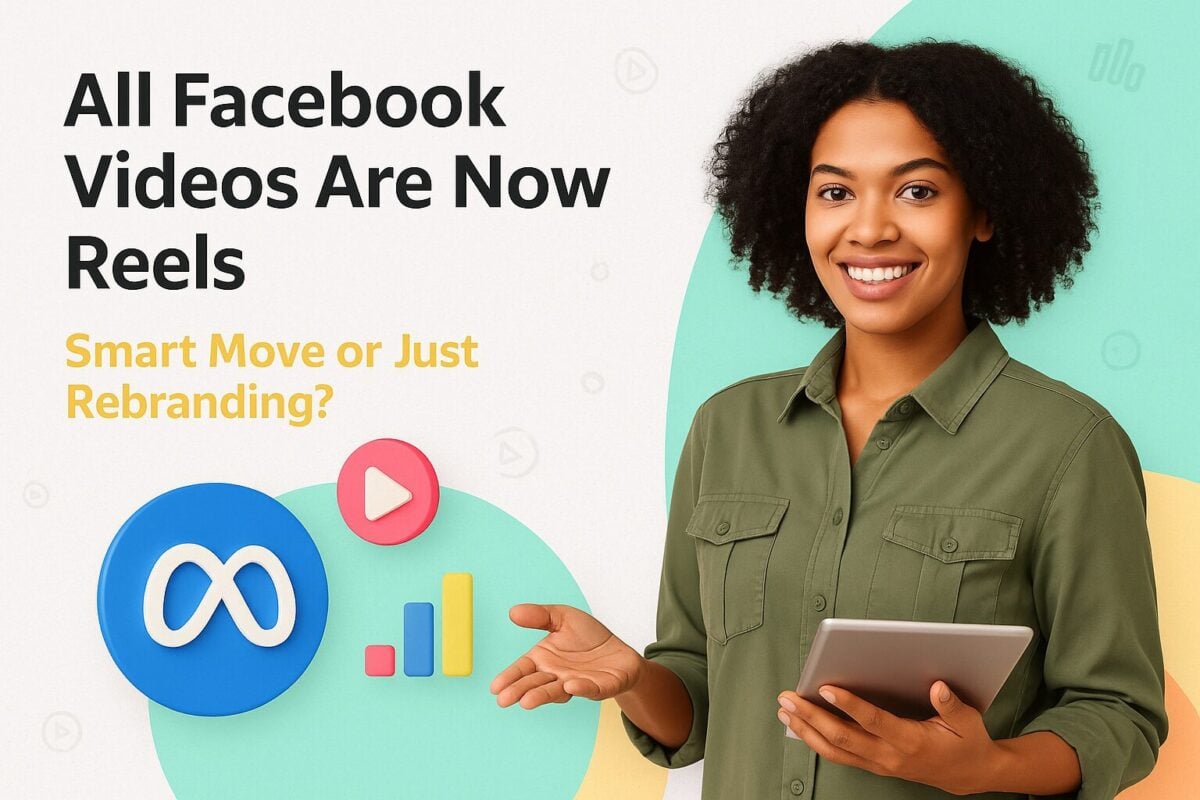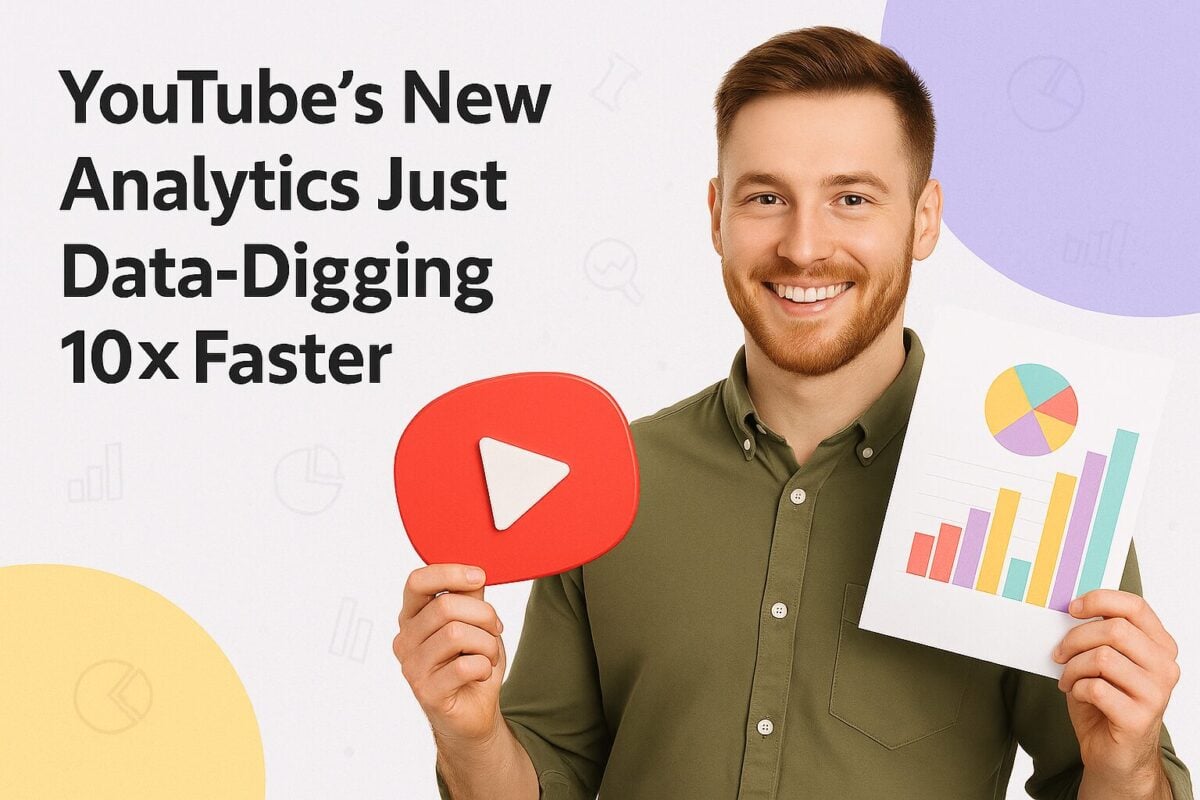Groups related to those topics. Look through the results to narrow down the most relevant groups you can join.
With longer buying journeys and larger investments involved, marketing to a B2B audience is a lot more complicated than B2C marketing. Thankfully, platforms like LinkedIn offer the perfect place to reach and engage with a B2B audience, especially decision-makers. In this guide, we provide you with nine winning LinkedIn B2B marketing strategies that will help you grow your brand.
Let’s get started.
9 Winning LinkedIn B2B Marketing Strategies to Grow Your Brand:
- 1. Publish Content that Adds Value
- 2. Get Your Post Timing Right
- 3. Engage in Relevant LinkedIn Communities
- 4. Create Groups that Draw in the Right Audience
- 5. Build Human Connections through Your Team
- 6. Ensure a Strong C-Suite Presence on the Platform
- 7. Segment with Dedicated Showcase Pages
- 8. Host Virtual Events and Involve Thought Leaders
- 9. Leverage LinkedIn’s Advertising Solutions
Why Use LinkedIn for B2B Marketing?
First of all, let’s look into the question of “why.” Why use LinkedIn for B2B marketing? According to the latest LinkedIn stats, the platform’s numbers are quite impressive. It has 850 million members, with 808 million users that marketers can reach.
And these aren’t just any users; there are more than 65 million decision-makers using LinkedIn. On top of this, more than half of these decision-makers say that they use LinkedIn content to determine which organizations to work with. This makes it the perfect platform to reach the people who are actually in charge of making decisions about which products to use and which vendors to work with.
From these numbers alone, you can clearly understand just how LinkedIn is for marketing to a B2B audience. Not only will you be able to build your brand presence, but you’ll also get the opportunity to showcase your expertise and credibility to the people who can make important buying decisions in their respective organizations. This can effectively help with your B2B social selling efforts.
9 B2B Marketing Strategies to Use on LinkedIn
Now that we have the “why” sorted, it’s time to get into the “how.” How can you use LinkedIn for B2B marketing? Here are some of the winning B2B marketing strategies that you can use on LinkedIn.
1. Publish Content that Adds Value
As mentioned earlier, when decision-makers vet organizations on LinkedIn, they’re relying on the content produced by the company to assess their expertise. So the content you produce is top priority when it comes to marketing on LinkedIn. You should be developing a B2B content plan that can add value to the lives of your target audience–whether it will teach them to do something or help them understand a topic better.
Unlike many other leading social media platforms, LinkedIn supports long-form publishing. In fact, it’s the only social media platform that lets you publish long-form articles directly. That means you won’t have to redirect your audience to an article from outside the platform since that might reduce the chances of them reading it. This makes it the perfect place for organizations to establish their expertise by discussing relevant topics in-depth.
At the same time, that doesn’t mean you should only post articles directly within the platform. It just means you can diversify your content offering by publishing a mix of articles, links, and media posts. What matters is whether you’re discussing topics that would be relevant to the needs of your B2B audience.
That’s exactly what Semrush does–they regularly publish content in a wide variety of formats. They create a mix of visual and text posts as well as links to diversify their content mix. But most importantly, they discuss topics that their target audience (mostly made up of marketers) will find valuable.
2. Get Your Post Timing Right
Just like on other social media platforms, timing is crucial on LinkedIn. You have to catch your audience at a time when they’re most likely to see and engage with your post. The more engagement your post gets, the better its visibility will be throughout the platform. This can help you massively grow your reach and get your brand in front of a relevant B2B audience.
Many experts have researched when is the best time to post on LinkedIn, and the results vary. However, according to our analysis of those studies, we can narrow down the best time to post on LinkedIn as 8-10 am on Wednesdays, 9 am and 1-2 pm on Thursdays, and 9 am on Fridays.
Keep in mind that these are just suggestions rather than a hard and fast rule because the optimal post timing may vary depending on factors such as your industry and your audience behavior. Instead, use them as reference points and experiment with different post timings to see what works specifically with your audience.
3. Engage in Relevant LinkedIn Communities
People value real connections and conversations with other humans. As such, LinkedIn Groups are the perfect place to engage with like-minded folks and build an authentic connection with people who might be interested in your offering.
By consistently being active in these groups, you could create an opportunity to discover and nurture leads. This is particularly effective for B2B marketing since a LinkedIn Group can have millions of members, meaning you can potentially connect with millions of real users relevant to your industry.
A simple search for niche or industry keywords will show you some of the biggest LinkedIn Groups related to those topics. Look through the results to narrow down the most relevant groups you can join.
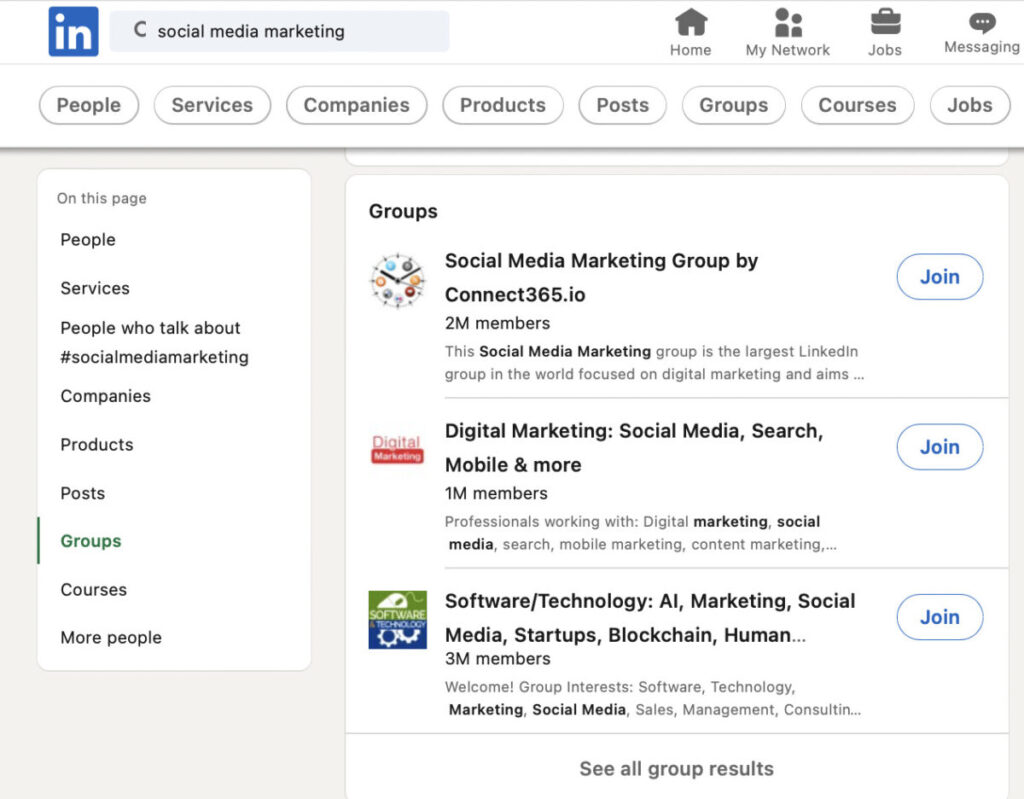
Source: linkedin.com
Scour these groups to see what kind of conversations people are having. This will help you figure out what people are interested in, what their pain points are, and what solutions they’re looking for. Then jump in on conversations that are relevant to your brand’s offering without being overly promotional. For example, you can share some tips related to someone’s questions, which will allow you to show your expertise and credibility.
4. Create Groups that Draw in the Right Audience
Some B2B organizations go beyond simply participating in LinkedIn Groups; they build an engaged community by creating their own group. Creating a group yourself allows you to be more in control of the community and conversations that take place.
That way, you’ll be able to create a group that meets certain needs and desires that weren’t met by another group in your niche. For example, if the other group is full of spam posts from other members, you can create a new group that’s more strongly moderated with established rules that prohibit such spammy behavior. Some organizations might even create groups dedicated to providing support for existing customers. This can be a great place for potential customers to see how well you’re engaging with your community.
Once you build a large enough community, you’d also be able to gain recognition and leadership in your industry. Plus, you’ll have more freedom to be a bit more self-promotional (albeit in moderation) to effectively market your offerings.
5. Build Human Connections through Your Team
When it comes to building authentic connections with your target audience, it’s the people behind your organization that matter the most. After all, people would sooner connect with other people than with a faceless company. That’s why it’s crucial to leverage the humanness of your employees to build connections that feel more human and more personal.
There are a number of ways to do this, including activating your employees through an advocacy program. You could get your team to share important company updates and other valuable brand content that their audience would be interested in. A Sprout Social survey on brand advocacy found that employee updates are the second most engaging type of social content. Moreover, 51% of engaged users are most likely to share this type of content.
Another effective tactic is to share employee stories and achievements through your brand’s LinkedIn Page. You could share their experiences and quotes along with their photos to show the human faces behind your organization. The same Sprout Social survey also found that 86% of respondents consider brands to be authentic when they post about their employee’s achievements and stories. Additionally, these brands were considered more approachable and interesting.
Here's a great example of IBM sharing one of their employees’ stories on the occasion of Women’s History Month. Along with a friendly and approachable picture of the employee, they shared her career journey that many might find relatable or even inspiring.
6. Ensure a Strong C-Suite Presence on the Platform
It’s not just your employees that can help you build a human connection with your B2B audience on LinkedIn. The type of presence that your C-suite executives have on the platform can make a huge difference in bringing your brand to life. Consumers are increasingly showing an interest in learning about the people behind the organizations they encounter. And your executives could help give them a closer look at what your company’s all about.
In fact, another Sprout Social survey found that 70% of consumers feel more connected to a brand when the CEO is active on social media. And 65% feel that there are real people behind the brand, while 56% enjoy learning about brand leadership. In other words, having a strong C-suite presence on LinkedIn could help leave a lasting impression on your target audience and further establish a bond with them.
Eddie Shleyner, who founded VeryGoodCopy, is highly active on LinkedIn. He regularly posts valuable and relatable content for his audience and has built quite an impressive presence on the platform with more than 95,000 followers. This has helped to bring his company into the spotlight, thus effectively marketing it to an engaged audience.
7. Segment with Dedicated Showcase Pages
It’s important to remember that not everyone follows your company’s LinkedIn Page for the same reason. While some may be looking for employment opportunities, others may be interested in your product offering. So the marketing material and content you produce may not necessarily resonate with everyone. To better ensure relevance, you can make use of Showcase Pages to categorize your audience into different segments.
Showcase Pages are dedicated Page extensions for individual brands, initiatives, and business units under your organization. These Pages will be listed as “Affiliated Pages” on your brand’s main LinkedIn Page, and people can follow the Page that’s relevant to their needs and interests.
LinkedIn itself has several Showcase Pages dedicated to different solutions and initiatives. For example, there’s a Page just for LinkedIn Ads and another for LinkedIn Learning. Each of these Pages will have a separate set of audiences with unique needs. While someone following the LinkedIn Ads page may be looking for solutions to market their brand, someone following the LinkedIn Learning page may be looking to grow their own skill sets.
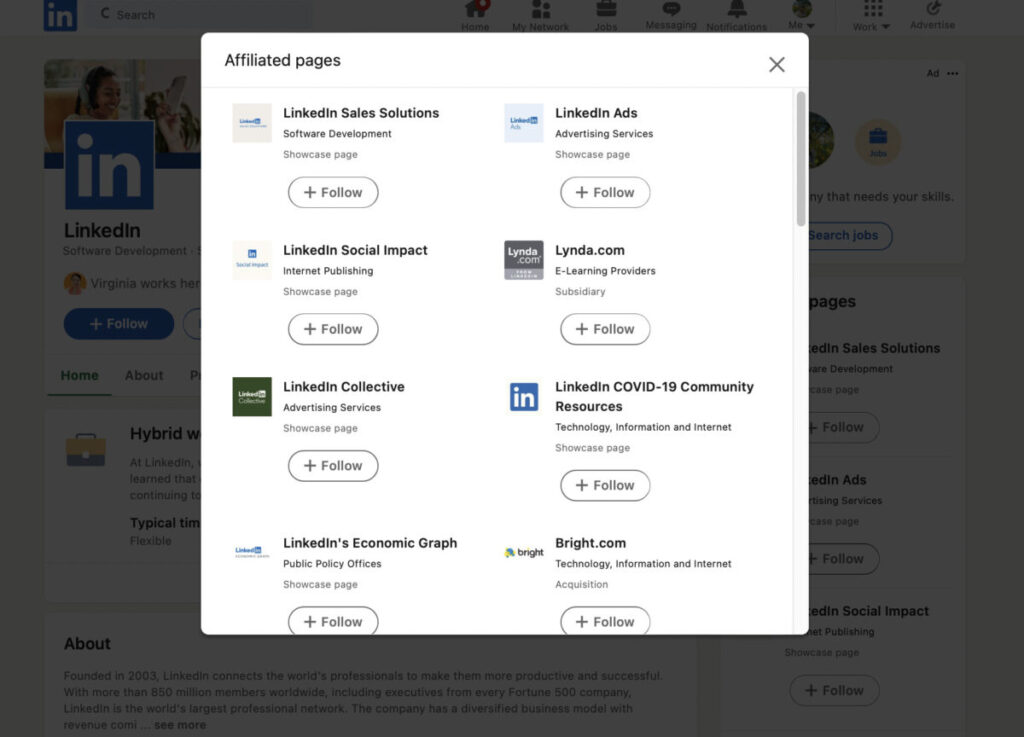
Source: linkedin.com
8. Host Virtual Events and Involve Thought Leaders
Virtual events are a great way to bring thousands of people together from different parts of the country or even the world. With LinkedIn offering solutions such as LinkedIn Events, it has become a lot easier for B2B companies to host their own virtual events all within the platform. This solution allows you to create an event within LinkedIn and host them through virtual audio sessions,
LinkedIn Live, or even through an external platform.
You can further amplify the reach of your event by engaging thought leaders. For instance, you could invite an influential LinkedIn personality to participate in the event as an interviewee, a panelist, or even a host. They can then help to promote your event by sharing it with their own audience and inviting them to participate. In other words, you’ll be leveraging LinkedIn influencer marketing to reach a B2B audience.
Moz regularly invites relevant thought leaders for their Whiteboard Friday events. These thought leaders then share the news with their own audience, helping to maximize the brand’s reach.
9. Leverage LinkedIn’s Advertising Solutions
Finally, don’t be afraid to invest in LinkedIn’s advertising solutions to exponentially grow your reach. This will involve creating targeted ads and delivering them to a highly relevant audience that would be interested in your offering.
You can choose between several formats and ad delivery methods for your LinkedIn ad campaign. LinkedIn will also let you fine-tune your targeting using several audience attributes. This may include company name or size, job title and seniority, skills, interests, Groups, and many more. So for example, you could target social media managers and social media marketing executives for your ad promoting an event on the latest social media trends.
Ready to Grow on LinkedIn?
Now that you have some of the most effective B2B marketing strategies to grow your brand on LinkedIn, it’s time to put these tips to good use. Start by reviewing your existing marketing and content strategy to see how you can incorporate the above tactics and improve your marketing results.

